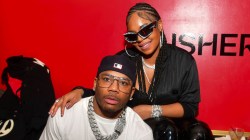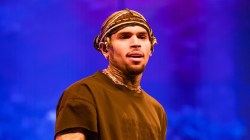You don’t often hear about a park serving as inspiration for a Hip Hop album, yet such is the case with Oddisee‘s latest, the (mostly) instrumental release Rock Creek Park. After moving to New York, Oddisee was reminded of Washington D.C.’s Rock Creek Park, a place he used to visit when he was younger, when he would ride through the parks in his new home town. Using the location as his muse and the ’60s and ’70s Funk and Soul he was listening to at the time as his sonic backdrop, the Diamond District member began crafting what would become a musical retelling of the moments and locations that defined his relationship with, and fondness for, Rock Creek Park.
Oddisee set out to make an album that could stand on its own, a collection of tracks that weren’t seen as simply a hollow group of blueprints lacking the words of an emcee but a set of musical compositions that could be appreciated by more than just those who knew him in the Hip Hop realm. The work’s warm soul sound and live instrumentation craft a unified sound, albeit one that’s hard to properly define at times. It’s an album that’s Hip Hop, but isn’t, yet still somehow still is. Labeling it is likely much harder than enjoying it, and if we take the album simply as it is, we find Oddisee carving out another notch in a career that grows more impressive with each passing year.
The DMV producer and rapper spoke with HipHopDX last week about crafting an instrumental album that needs no lyrics, the mental blueprints that lead to his tracks, and making music for others instead of himself.
And for those who keep asking for his instrumentals, he doesn’t have any extras lying around. Really.

AD LOADING...
HipHopDX: You’ve described this album as a “soundtrack to your memories and experiences in Rock Creek Park.” Can you describe the influence that the location had on your album and how you arrived at the initial idea for the project?
Oddisee: It started when I moved to New York and bought a bike and started riding around the city. I found myself in Prospect Park and Central Park and I realized how long it had been since I had done that back home in [Washington] D.C. in Rock Creek Park and how much I really appreciated and enjoyed it. That started reminding me of all of my experiences back home. [Around the same time], I was approached by Michael Tolle from Mello Music Group to do another instrumental album. [The idea] just spoke to me. As always, I knew I wanted to base the project off of something that was relevant to me. I do my best to do that with my projects, and it just popped out at me that I should make it about the park. I think it was just the timing of me riding around Prospect park and Central Park and then being asked to do an instrumental album.
I suppose a lot of the music I was listening to while I was riding my bike influenced that decision as well. [I was] listening to a lot of Funk and Soul from the ’70s and late ’60s.
DX: And those songs played into your sample choices as well, either directly or indirectly?

AD LOADING...
Oddisee: Definitely. It definitely crafted the sound. [The album] has a nostalgic vibe to it.
DX: There’s a real air of reminiscence that weaves its way throughout the album, be it in the titles themselves or the music’s almost curious tone. Was that your intent when you set out to do the project, to create an album that felt nostalgic?
Oddisee: That’s a tough question. I actually named every track after the entire album was done. When I make music, each track [is] named after the date and the time of day that it was made, so every song in my files, until it’s released, is just a number. I knew I had the title for the album, and I knew I wanted to base titles around the park. Each one of those titles just jumped out at me because it sounded, to me, like those titles. “Skipping Rocks” sounded like skipping rocks to me. “Clara Barton” sounded like when I’m riding and taking the Clara Barton Parkway to get to Rock Creek Park. In a sense, they sort of named themselves, you know? The music is definitely always first and the titles are second.
DX: My favorite track on the album, “The Carter Barron” , is one of the cuts that made the rounds on the rap blogs. Tell me a bit about how that particular track came together.
, is one of the cuts that made the rounds on the rap blogs. Tell me a bit about how that particular track came together.

AD LOADING...
Oddisee: “The Carter Barron” came about when I had this really dynamic and bright and epic melody and riff. I’m blessed to be around some beautiful musicians that can pretty much play anything that I can whistle and hum and play to them. It just came to life really through the live instrumentation and the marriage between the live instrumentation and the samples. By the time I was done with it, it definitely reminded me of when my mother would take me to free shows at the Carter Barron [Amphitheater]. Being a child, I hadn’t gone to that many live concerts, so there was a big difference between hearing music on the radio and hearing music in a car stereo or a home stereo and hearing music at an amphitheater. So “The Carter Barron” was really one of my earliest memories of listening to live music at an amphitheater. That’s definitely where that title came from and why the sound is so big on that one, because that was pretty much my first memory of listening to music on that scale.
DX: The album as a whole sounds like it truly merges live instrumentation with sampling. It’s almost seamless, so much so that it’s often hard to distinguish between what’s a sample and what was added. Was that part of your focus going into the project, to really blur that musical line?
Oddisee: Definitely. That was definitely my intention, and it’s funny. That’s been, I guess, a part of my style for the past four years, of blending live instrumentation with sample-based percussion, but it’s never been the focus on one of my instrumental records. I do it often on songs that I’m producing or songs that I’m rhyming on. On the Diamond District [In The Ruff] album, there’s a lot of live instrumentation on it but people would never know just because of the sound of it. On Traveling Man, there’s a lot of live instrumentation. I think the reason people know now is because I used a lot more acoustic instruments on this record and there were a lot more solos to focus on. And strings – I use a lot more strings on this record. Strings are always one of the more obvious instruments where you can tell if they were sampled or not.
I wanted to blend samples with the live instrumentation in a way where I would sample those same instruments and then have artists play over the top of those instruments or replay those instruments. A lot of the tracks with strings had strings that I either replayed so that I could change the melody or make them sound more dynamic or play over the top of them to make them sound more lush. I think that’s where that seamless sound comes from, because a lot of those instruments already exist within the samples as well.

AD LOADING...
DX: You gave AllLindstrom.com a track-by-track breakdown of the album, and when you spoke on “The Carter Barron,” you said “this is the track that I wanted to inspire emcees to rhyme on but second guess.” Can you shed a little light on that particular quote?
Oddisee: That quote is a feeling I had when I started to produce and create Hip Hop, this feeling of self-doubt, like wanting to do something but second guessing myself until I was good enough or making sure that I didn’t step outside of my range or my means. That’s what I wanted [the track] to do – the whole album really. I wanted it to constantly have this element of Hip Hop that would draw you in but then you’d realize “This is a bit more than just Hip Hop. Maybe I shouldn’t rhyme over this. Maybe this is just pure music.”
[I wanted] to bring about that question – “Can you produce a Hip Hop instrumental album that is just to listen to?” – because there’s plenty of other genres [where artists] can create instrumental albums that people have no problem listening to. The phrase “Oh, I have to rhyme on this” or “I have to sing on this” doesn’t come up. Can that be possible with a Hip Hop instrumental album where it is a Hip Hop record? Definitely. But there’s something about it that says “I should just listen to this.”
DX: You feature yU on the first track, “Still Doin It.” Why the choice to not go with a full instrumental album?

AD LOADING...
Oddisee: Several reasons. I’m always thinking with my business hat on and my artist hat. It’s great promo for a record if you have one vocal song. You can anchor a record by sending that to the blogs for free. You can help people craft their perception of the record, [plus] there’s a better chance of shooting a music video.
[As for the] artist reason, if you notice, I wanted people to make sure that they realized that the album started and ended in Hip Hop, that it was a circle: the first track comes in and it’s a Hip Hop record, and throughout the rest of the album there are different genres but at the end the last track is a traditional, straight-up boom bap Hip Hop song. [I’m] basically saying to my audience that no matter what I do and no matter what sounds I go through, no matter what musical endeavors I choose, I came into this game through Hip Hop and I’ll end through Hip Hop.
DX: Earlier you mentioned that you always have to start with an idea that is relevant to you before you can get working on a project. Is that generally how you work, going in with that overarching theme that dictates where everything else goes?
Oddisee: Definitely. I feel for today’s market, you almost have to have a theme in order to capture people’s attention, and I’ll spend more time crafting the theme than I will producing the record. I can see records in my head for months at a time before I genuinely decide to work with them because I’ll have to have the blueprint finished before I start. It took me 10 days to produce Rock Creek Park, but I had been thinking about producing Rock Creek Park for about four months.

AD LOADING...
DX: You just had these separate ideas in your head for months and you were able to compartmentalize them?
Oddisee: Always. Always. I’ve been working on March On Washington, Diamond District’s follow up, before Rock Creek Park, and all of those notes are still in my head. My solo album – I’ve been working on that more than all of them, and all of those notes are still in my head [too]. They just kind of stay up there. When it’s time to work on the record, I know what to pull from.
DX: Man, that’s impressive.
Oddisee: It’s pretty weird, but I’ve kind of always been that way when it comes to music. I have to have the whole thing done in my head first, you know?

AD LOADING...
DX: So it’s not even written down with notes – ideas about what to sample or what to add? The blueprint’s all just up top?
Oddisee: Yeah, it’s kind of like a vibe that I store. It’s basically that I’m saying in my head “I want something that’s really, really upbeat on one track and I want it to kind of sound like this. And then one track, I want it to sound really, really epic. But if I have this really, really epic track, I need to counter it with something that’s really downtempo and chill. And if I make the chill track, then I need to make something that’s kind of between both of them to bring the overall energy of the album back up, but if I bring the energy of the album back up, then I need to close it with a track that sounds something like this…” It’s a puzzle that pieces itself together, and once that whole puzzle is complete, I start producing the record.
When I start to sample and work with artists, I’ll say “it’s time for the upbeat track” or “it’s time for the downtempo one” or “it’s time for the medium one” or “it’s time for the closer or the intro.” And I know exactly what kind of samples to look for and what musicians to bring in and what tempos and what drums I want based on the description I have in my head.
DX: It sounds like with that kind of blueprint, your process lends itself to creating a really even-handed album instead of having too much of one thing or something else.

AD LOADING...
Oddisee: Exactly. There’s more than one way to skin a cat. A lot of artists will work on 30, 40 tracks plus and cut the best ones to a make an album, but I’ve always – whatever I produce is what’s going on the record, you know?
DX: So you don’t end up having a lot of extra tracks, at least for specific projects?
Oddisee: I never do. Hip Hop emcees are always so upset. They hit me up and they’re like “Yo, I need beats! I know you’ve got a million beats lying around!” I’m like “Yeah, actually I don’t” and they never believe me. I work on just a project-to-project basis, so I never have extra tracks lying around.
DX: Now that Rock Creek Park‘s been released, what’s next for Diamond District and your solo career?

AD LOADING...
Oddisee: Up next for me is my solo album, People Hear What They See [then] Diamond District’s second album March On Washington. I’m producing a whole album for yU. We haven’t even titled it yet. I have an album I produced for Finale that’s been done for about two years. Whenever that comes out, I’ll let you know. People Hear What They See will be the first out of everything that I named and we’re still trying to work out the release date right now. I’ve gotta record two more songs when I get back to New York.
A lot [is] in the making. I think I’m gonna go ahead and get back on my producer game as far as working with a lot of outside artists and producing individual tracks. I’m gonna be focusing a lot more on music licensing in 2012. Expect to hear me in a lot more commercials and films and things of that nature. I’m just kinda taking it easy and getting ready for the storm.
DX: I read that when you first started producing, you were reluctant to use samples that you’d heard other producers use and you had other self-imposed rules that you would follow. Were there any specific rules you tried to stick to when you were working on Rock Creek Park?
Oddisee: Nah, homie, all them rules is out the window. [Laughs] If it sounds good, I run with it now. I guess, getting a little older and getting wiser, those rules, to me, were good in my formative years of being a producer but I don’t think they apply to me any more. The only thing that matters is the end result.

AD LOADING...
DX: As long as it fit that soulful sound that you were aiming for on this project, right?
Oddisee: Exactly. And in the end, I guess I started realizing that even though I’m an underground independent Hip Hop artist, I still have the responsibility of making music for other people. I’m still an entertainer. A lot of those rules are self-imposed and don’t really matter to the listener. They’re not putting the listener first; they’re putting my preferences first. And that’s cool. I definitely have to meet my own expectations, but I focus more on the listener’s experience these days more than my own.
You can purchase Rock Creek Park in stores or digitally through Mello Music Group. Follow Oddisee on Twitter (@Oddisee).



